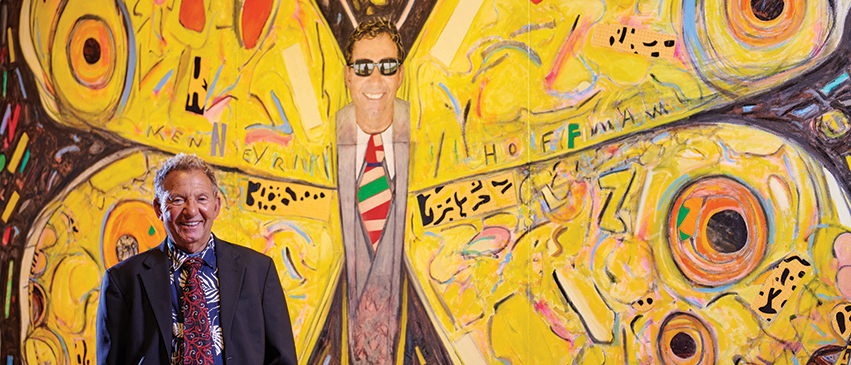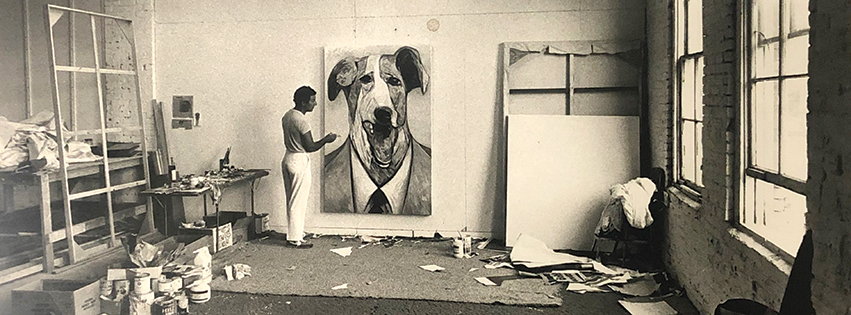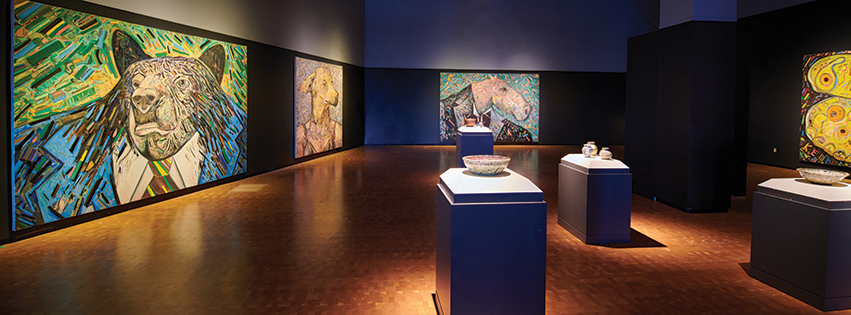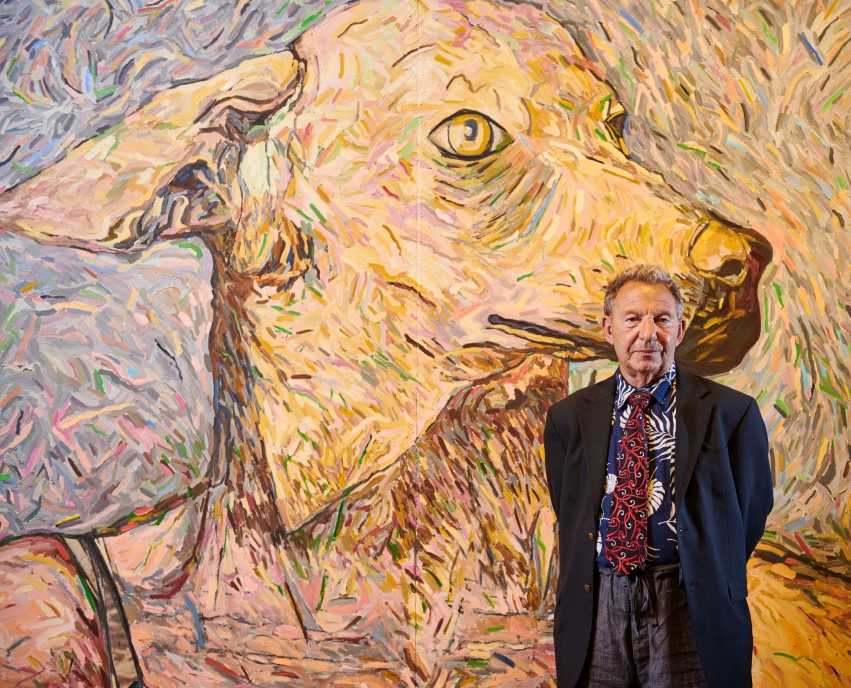
When Ken Hoffman arrived in Peoria in 1969, he embarked on a half-century journey as one of the Midwest’s premier expressionist painters. A graduate of the San Francisco Art Institute, he taught at Bradley University for over four decades while perfecting a trademark style that juxtaposes the human-like features of animals and animal-like qualities of humans with a generous helping of social critique.
Though best known for his anthropomorphic animal portraits—birds, pigs, cats and monkeys dressed in suits and ties—Hoffman’s body of work has also encompassed large-scale murals, thrown pottery and scattered elements of collage. His current exhibition at the Peoria Riverfront Museum, “Ken Hoffman: 50 Years in Peoria”, explores this artistic journey: bright and bold, humorous and insightful, unmistakable and inimitable.
What was your childhood like growing up in Texas?
I had a terrible childhood. My father Max was an alcoholic. My mother, sister and I were hostages. Max beat up my mother continually. There was no art, books or culture—my life was boxing, football and hunting. I fired my first shotgun at age seven and was blown down from the blast. Max set up my first fight at 10, complete with a boxing arena and other fighters. His idea of fun was to play Russian roulette on a Sunday afternoon. I played high school football for three years and was too small and thin at right halfback. My being on the football team was the best part of high school. I made good friends and developed social skills that I used all my life.
What inspired you to become an artist?
Before leaving the Navy, I took an R & R up to Tokyo from Guam. Wandering around Tokyo one day, I stumbled into the Tokyo Museum of Art. They were having a show from Paris of Impressionist paintings. The show just blew my mind, and I felt like this was something I wanted to do. I started making small paintings aboard ship, and when I returned home, I took a summer drawing course at Baylor University.
How did you decide to attend the San Francisco Art Institute?
I was studying drawing at Foothill College in Palo Alto, California with Ron Benson, and he liked the way I drew—very loose and free with ink and wash. “You draw like Richard Diebenkorn, and you should transfer to the San Francisco Art Institute. I will call admissions and recommend you.” At that time I had never heard of the San Francisco Art Institute.
What impact did the school have on you and your work as a young artist?
Studying at the Art Institute was very intense, and I had a lot of catching up to do with my paintings and drawing in both technique and concepts. My work starting out looking a lot like outsider or primitive art, and I was struggling to find enough money to buy my supplies. I was dumpster diving and used what I could find, painting on cardboard or Masonite, and using buckets of commercial paints. I was also an older student, 26 years old, and fresh out of the Navy. The instructors I studied with were patient, kind and helpful and gave me plenty of room to explore and develop my work. For me it was 24/7, plus I carried a part-time job at the Institute.
What about the city itself?
Living in San Francisco from 1964 to 1968 was absolutely an incredible experience! The music, the jazz, the culture, City Lights Bookstore, museums, art galleries, and especially North Beach. I was walking one night in the heart of North Beach and passed by this café/bar, giving a quick glance inside. Who was sitting there at the window table playing chess? None other than Allen Ginsberg and Jack Kerouac!

What was the Peoria arts scene like when you first came to town?
The Peoria art scene was alive and well when I arrived in 1969. There was a lot of energy and excitement being generated by the artistic community, being made up of patrons of the arts, museums, galleries, universities and community colleges. Poets were being published, along with other important writers. The music scene was at a feverish level with concerts—rock bands, jazz, hard metal, chamber music, both local and out of town. There was always a party going on. My wife and I gave a party at our house, including students and the Bradley crowd, and I somehow wound up on the kitchen floor, high on pot and cheap wine. I could not get up from the floor. I began yelling for my clarinet and played the old standard, “Twinkle, Twinkle, Little Star.”
Tell us about your time at Bradley University. What was your favorite part of being a teacher?
I had a long career at Bradley—43 years. There were good years and there were difficult years, as in any large organization. The best part for me were the students. I loved all of them, and there were many times I was studying with them instead of them with me. I got so much back from them and I worked with some really talented students throughout the years. I had one beginning painting student who was so nervous about how to start his painting so that his hand was shaking when he held his brush. I told him to take the brush, mix up some blue, and just sweep the paint across the canvas until it starts to feel good. I came back 20 minutes later and his whole canvas was covered with thick blue paint. I liked to use profanity in the classes, and I would many times yell out, “Paint the shit out of it!”
What inspired your initial large-scale mural work in 1970?
I had always wanted to do a large-scale painting, and when I got to Peoria my wish came true. Two of my fellow painting instructors at Bradley found a 17,000-square-foot studio space in the Merkle Building in downtown Peoria, so they invited me to share the space and help pay the rent. I had a 46-foot wall to paint on, and set to work. At that time I was a big fan of Joyce Carey’s novel The Horse’s Mouth. The British painter John Bratby had painted all the works that were shown in the movie version, and I was completely blown away… the distortion of the figures, thick paint, use of strong color combinations, and incredible scale of the paintings. So I became Mr. Jimson [the book/film’s lead character] and began my five big murals. I got a lot of press from the Journal Star, and I remember one woman wrote to me telling me how offensive and ugly my painting was to her and that I was an awful artist. “Don’t paint anymore!” she said. I went right to work on another piece.

When did you begin focusing on animals and their human-like qualities? Why do you think that has kept your interest all these years?
The animals came out of parts of the big murals. At the end of the mural series, I was completely burned out and exhausted. So I selected one of the animals, a pig, and just used his head as a portrait motif. I worked small, 35 by 35 inches, and thought, ”Let’s put him in a tuxedo and see what happens.” I really liked what I had done, and then another pig portrait and then another. I was hooked on where this was going. I even had a show of my pig paintings at the Dubuque Art Center. I thought, “Hey I am going to sell something here, the Armour Company headquarters.” So we had the opening reception and a couple came in and kept staring at the paintings, and especially me. Finally he came over and said, “I don’t like your paintings. I’m a member of the Dubuque Police Department and you are making fun of us!” “Sir, I am not making fun of the Dubuque Police Department. These paintings are based on the book Animal Farm, a fantasy where the pigs take over the world.” He said, “I don’t care where they came from, you’re making fun of me!” It was the ‘80s.
Describe the role of collage in your work. Where do you find the items you attach to your paintings?
I love working with collage. I follow in the footsteps of Picasso, Braque, Rauschenberg and Basquiat. I think it started at the Institute, when I would tear up bad figure drawings and collage them on top of other drawings and paintings. I’ll use anything and everything, a lot coming now out of the Illinois River. I also find things in parking lots, drive-ins, walking through neighborhoods, outside restaurants, all types of magazines and newspapers, old drawings and billboard papers.
Many of your pieces contain an element of humor. Is this by design? Do you use humor to send a message?
I think the humor part comes in after I have worked with the piece for a while, or maybe it begins right away. Some of the work I make is just funny and some of it more serious, loaded with social commentary, and these can get pretty nasty. I really don’t use humor to send a message. What message? I never really think about it. I just paint. The paint tells me what to do.
How is your pottery work similar to (or different from) your paintings?
Pottery and painting are all the same energy. I can paint on pots and I can use clay on paintings. I also do a lot of drawings with markers. I draw on everything: newspapers, cardboard, food bags, sketch pads, colored papers.

Your wife Barb is a fantastic fine art photographer. Do the two of you work together? How has she influenced your work and artistic career?
We never work together. She has her studio and I have my studio. We meet for critiques and lunch from time to time. We exchange ideas and give feedback and encouragement to our work. We do a lot of hugging and kissing. I always see figures in her work, and she always comments that the eye on my bird painting is not right and that it needs to move to the left more, or it is too high up on the head. Barb has given me undying support, love, encouragement patience and understanding. She has been a great influence on my career.
What’s next for you in your artistic journey?
Keep on keeping on! PM
“Ken Hoffman: 50 Years in Peoria” is on display at the Peoria Riverfront Museum until September 6, 2020. For more information, visit riverfrontmuseum.org.
- Log in to post comments

